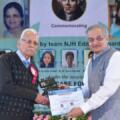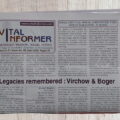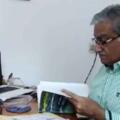The concept of “legacy” is both profound and multifaceted, transcending mere reputational posthumousness to embody lasting contributions that continue to influence and shape the field long after an individual has passed. A legacy serves as a kind of living monument, a testament to a person’s life’s work, and a focal point around which new generations of scholars and practitioners can rally. It implies not only expertise and accomplishment but also enduring impact, the kind that weathers the vicissitudes of time and the inevitable evolutions within any discipline.
In the realm of homeopathy—a field inherently rich with historical contributions and enduring methodologies—the term “legacy” takes on even greater weight. Homeopathy is not just a medical approach; it is a system of healing that has evolved over centuries, incorporating the wisdom and insights of many who have dedicated their lives to understanding the interplay between the human body, natural substances, and holistic well-being.
Within this intricate tapestry of knowledge and practice, the name Dr. Cyrus Maxwell Boger stands as an indelible mark of scholarly and practical excellence. His work has not only advanced the field during his time but has laid an enduring foundation upon which subsequent generations of homeopathic doctors have built their own practices and understandings. Dr. Boger’s methodologies, writings, and teachings serve as a cornerstone in a larger edifice of homeopathic thought, one that has stood the test of time and continues to inform contemporary practice.
This blog post is an academic exercise aimed at not just retracing the footsteps of Dr. Boger but also understanding the manifold ways in which his work continues to influence homeopathy today. Our discussion will draw heavily from the comprehensive research encapsulated in the recently published book “Boger’s Legacy & Augmenting the Synoptic Key’s Repertory,” by Dr. Anil Singhal, MD(Hom.). Through this lens, we will delve into both the minute details and the broad strokes of Dr. Boger’s work, charting a journey that was not just about the man himself but also about the enduring legacy he has bequeathed to the world of homeopathy—a legacy that is nothing short of unparalleled.
Boger’s Journey: The Making of a Homeopathy Legend
The roots of any great legacy often lie in seemingly mundane beginnings, and Dr. Cyrus Maxwell Boger was no exception. Born in the year 1861 in Western Pennsylvania, Boger was a product of his environment—an environment that was a crucible of intellectual curiosity, scientific rigor, and a nascent but growing interest in alternative methods of healing. These early influences would become the bedrock upon which Boger’s remarkable career was built.
Foundations: Early Life and Education of Boger
Boger’s early life was a mix of intellectual pursuit and societal norms. His family, a supportive unit, fostered in him the importance of education and instilled values that would later become evident in his meticulous work. His formative years were marked by a keen interest in science, perhaps a precursor to his later endeavors. These years were formative not just academically but also in shaping the ethical and intellectual framework that would guide him throughout his life.
Transition from Pharmacy to Homeopathy: Boger’s Educational Journey
Interestingly, Boger initially ventured into the world of pharmacy, a domain closely linked but distinctly separate from homeopathy. It was a field that promised a respectable livelihood and a chance to delve into the intricacies of medicinal science. But as fate would have it, or perhaps guided by an intrinsic pull towards a more holistic approach to medicine, Boger found himself at a crossroads. This period of his life, elaborated in the section ‘Transition from Pharmacy to Homeopathy,’ was a turning point, redirecting his professional journey in a manner that would later have far-reaching implications in the world of homeopathy.
Building a Legacy: Boger’s Journey in Homeopathy
It was this transformative pivot from pharmacy to homeopathy that set Boger on a path of lifelong learning and contribution. This was not merely a change of academic interest; it was a profound shift that reflected a deepening understanding of human health and wellbeing, one that transcended the symptomatic treatment of ailments to address root causes. Boger didn’t just adopt homeopathy; he enriched it. Through extensive research, practice, and publication, he not only mastered existing frameworks but also contributed original thought, thereby carving out an intellectual space that would be referenced by homeopathic practitioners for generations to come.
An Unmatched Legacy in Homeopathy
As he delved deeper into homeopathic practice and scholarship, Boger quickly distinguished himself as a stalwart in the field. His influence was not confined to the United States but rippled across continents, shaping academic discourse and clinical practice alike. And so, what started as a journey of a young man from Western Pennsylvania into the field of pharmacy had metamorphosed into an odyssey that would leave an indelible mark on the world of homeopathy.
In sum, Dr. Cyrus Maxwell Boger’s journey was characterized by intellectual curiosity, transformative educational experiences, and an enduring commitment to advancing the field of homeopathy. It was a journey that commenced in the classrooms of pharmacy but found its ultimate expression in a legacy of homeopathic excellence that remains unmatched to this day.
Boenninghausen’s Repertory: The Foundation of Boger’s Legacy
The notion of a ‘legacy’ often presupposes the existence of predecessors, intellectual debts, and inspirations that shape the course of an individual’s contributions to a field. In the case of Dr. Cyrus Maxwell Boger, the intellectual lineage traces back most notably to Baron Clemens Maria Franz von Boenninghausen, whose repertory and principles served as a springboard for Boger’s own monumental work. Understanding this relationship is pivotal to appreciating the breadth and depth of Boger’s contributions to homeopathy.
Deep Impact of Boenninghausen on Boger
The sphere of influence that Boenninghausen had on Boger is not merely historical trivia but a substantive fact that shaped Boger’s approach to homeopathy. Boenninghausen’s methodologies, classifications, and understandings of symptoms were groundbreaking in their own right and provided a rigorous structure that Boger could build upon. It would not be an exaggeration to say that the scholarly underpinning of Boger’s work can be traced back to the philosophical and practical foundations laid by Boenninghausen. This profound impact is meticulously detailed in the subsection ‘Deep Impact of Boenninghausen on Boger,’ shedding light on how the mentorship, albeit posthumous, guided Boger’s steps in the complex maze of homeopathic theory and practice.
Refining Boenninghausen’s Approach: Boger’s Response
While deeply respectful of Boenninghausen’s work, Boger was not a mere disciple who unconditionally accepted his predecessor’s methodologies. As any scholar of repute would do, he engaged critically with Boenninghausen’s principles, seeking to refine, and even redefine, certain aspects that he felt could be improved upon. His rigorous scrutiny led to his own set of revisions and additions to Boenninghausen’s Repertory, making it more contemporary and versatile for practitioners.
The Birth of BBCR: Boger’s Extensive Compilation
It was this marriage of deep respect and critical engagement with Boenninghausen’s work that eventually culminated in the publication of the BBCR (Boenninghausen’s Characteristics and Repertory). This was not merely an act of homage but a monumental scholarly endeavor that sought to carry Boenninghausen’s legacy into the new century. The BBCR served as a comprehensive compilation of insights and clinical wisdom, replete with Boger’s own revisions and perspectives.
A Lasting Legacy Rooted in Boenninghausen’s Principles
In effect, the BBCR became a cornerstone in homeopathic literature and practice, setting the stage for future scholarship and application. More importantly, it ensured that Boenninghausen’s original principles were not only preserved but also revitalized, thereby extending their life and relevance in modern homeopathic practice.
Thus, when one speaks of Boger’s legacy, it is intrinsically tied to that of Boenninghausen’s. Just as architects may build upon the groundbreaking structures of their predecessors, so too did Boger build upon Boenninghausen’s foundational work. Through this extensive intellectual and practical engagement, Boger ensured that his own legacy, as well as that of Boenninghausen, would leave a lasting imprint on the world of homeopathy.
The Synoptic Key: The Apex of Boger’s Legacy
While Dr. Boger’s contributions to homeopathy are numerous and influential, the zenith of his scholarly output is undeniably encapsulated in “The Synoptic Key of the Materia Medica.” This seminal work, which stands as a monument to Boger’s intellectual acumen and clinical insights, can rightly be termed the apex of his lasting legacy. The following discussion aims to explore the multifaceted dimensions of this magnum opus, traversing its historical trajectory, methodological distinctiveness, and enduring impact on homeopathic practice and education, both in the United States and in India.
Deciphering Forewords of Different Editions of the Synoptic Key
It is often said that the beginning holds the essence of the entire journey, and in the case of “The Synoptic Key,” the forewords to its different editions serve as rich testimonials to Boger’s evolving thoughts. Each foreword acts as a mini-archive, capturing the ideological shifts, methodological refinements, and topical focuses that marked each edition. These introductory words serve as both a prologue and a contextual guide to understanding the shifts in Boger’s intellectual landscape, thereby offering invaluable insights into his ever-evolving legacy.
Key Insights: Forewords Across Editions
Reading the forewords across editions is akin to tracing the evolutionary tree of Boger’s intellectual endeavors. Each subsequent edition builds on the preceding ones, either by introducing innovative concepts, refining existing methodologies, or amplifying the repertoire of clinical wisdom. These forewords, therefore, act as a panoramic lens through which one can appreciate the expansive scope and depth of “The Synoptic Key,” as well as Boger’s indelible imprint on homeopathy.
Boger Through Sankaran’s Lens: A Tribute to a Visionary
It’s not just Boger’s own words that elucidate his monumental contributions; even contemporary homeopathic stalwarts like Dr. P. Sankaran have paid tribute to Boger’s influence. The appreciation from succeeding generations of homeopaths adds another layer to Boger’s legacy, emphasizing the enduring relevance of his work.
Boger’s Methodical Precision: Ensuring Quality
“The Synoptic Key” is not just voluminous in content but also exacting in its methodological rigor. Boger’s meticulous attention to detail and commitment to methodological precision ensure that the work stands not merely as a collection of medical observations but as a highly organized, reliable reference for both academic research and clinical practice.
The Synoptic Key’s Role in U.S. Homeopathic Education
In the United States, “The Synoptic Key” has been widely recognized as an invaluable educational resource, foundational to the curriculum in homeopathic schools and colleges. Its influence spans both introductory courses and advanced seminars, demonstrating the work’s versatility and comprehensive nature.
Boger’s Legacy in Indian Homeopathy
The reception and influence of “The Synoptic Key” in India constitute another noteworthy aspect of Boger’s legacy. It has become an indispensable part of the homeopathic educational system in India, as well as a reference manual for practicing homeopaths, thereby transcending geographical and cultural boundaries in its impact.
In conclusion, “The Synoptic Key of the Materia Medica” is not just a book but a rich tapestry woven with threads of scholarly rigor, clinical wisdom, and pedagogical utility. It is, in every sense, the pinnacle of Dr. Cyrus Maxwell Boger’s legacy, embodying the highest ideals of homeopathic practice and setting a gold standard for future generations of homeopaths to aspire toward.
Augmenting the Synoptic Key’s Repertory: Proposing New Additions
In the sphere of homeopathic medicine, where tradition and innovation often find themselves at a complex crossroads, the concept of “legacy” cannot be limited to the archival or historical. A true legacy is a living entity; it must be responsive to new understandings, clinical exigencies, and evolving medical paradigms. Dr. Cyrus Maxwell Boger’s influence, enshrined in his masterwork “The Synoptic Key of the Materia Medica,” is no exception to this dynamic vitality. The section entitled “The Enhancement of BSK-VI” provides a roadmap for how Boger’s already monumental work can be taken to new frontiers, perpetuating its relevance and ensuring its applicability to the needs of modern homeopathic practice.
The Enhancement of BSK-VI
The notion that even a masterwork like “The Synoptic Key” could be improved upon is a testament to the living, breathing nature of Boger’s legacy. The Enhancement of BSK-VI (Sixth Edition) involves not merely the addition of new clinical observations or remedies but signifies a structured and comprehensive effort to make this cornerstone text even more robust and versatile. The goal is to build on the solid foundation that Boger established, taking into account new findings, experiences, and methodologies that have emerged in the homeopathic community.
Identifying the Absent Remedies
An initial step in this transformative process involves identifying gaps in the existing framework. Modern homeopaths, armed with a combination of clinical experience and scholarly research, have the opportunity to fill these gaps by identifying absent remedies or even new clinical conditions that Boger himself might not have encountered. This practice of “gap identification” ensures that the Synoptic Key’s repertory remains a dynamic document, continually enhanced by the collective wisdom of the homeopathic community.
Clinical Assessment and Community Validation
The inclusion of new remedies or modifications to existing ones is a meticulous process that requires rigorous clinical assessment and validation by the homeopathic community. A proposed remedy undergoes multiple phases of clinical trials, peer reviews, and even community-based evaluations to ascertain its efficacy, safety, and relevance. This cyclical process of assessment and validation ensures the preservation of the scientific rigor and methodological integrity that are hallmarks of Boger’s original work.
List of Proposed Remedies for Addition
An essential component of this ongoing work is a clear and detailed list of proposed remedies for addition. These propositions are made transparent to foster community engagement and scholarly debate, acting as open invitations for collaborative research and clinical testing.
Looking Ahead: A Proposal for Future Development
While the enhancement of the sixth edition of “The Synoptic Key” constitutes a significant step forward, it is not an endpoint. Rather, it is a launching pad for ongoing innovations and refinements, thereby ensuring that Boger’s legacy not only endures but also thrives in the fast-paced, evolving landscape of contemporary homeopathic medicine.
Homeopathy Timeline of Boger’s Legacy
The word “legacy” is imbued with a sense of finality, as if it pertains exclusively to contributions that are complete and no longer in a state of flux. However, the concept is far more nuanced, especially in the context of a scientific discipline like homeopathy. The timeline of Dr. Cyrus Maxwell Boger’s contributions to homeopathy bears testament to this fact. His legacy is neither a static nor a finished entity; rather, it is a rich tapestry woven from various phases of his life’s work, influenced by different epochs in medical history, and continually enriched by ongoing scholarly and clinical endeavors.
Early Influences and Academic Foundations
Before one can understand the intricate body of work that constitutes Boger’s legacy, it’s essential to comprehend the foundational years that shaped his intellectual and professional trajectory. This includes his early life and education, as explored in the chapter ‘Boger’s Journey: The Making of a Homeopathy Legend.’
The Boenninghausen Era
Following his initial foray into homeopathy, Boger entered into a scholarly dialogue with existing paradigms, notably Boenninghausen’s repertory. The chapter ‘Boenninghausen’s Repertory: The Foundation of Boger’s Legacy’ delves into how he not only built upon but also refined Boenninghausen’s approach, culminating in the seminal work of BBCR.
The Synoptic Key: The Magnum Opus
The cornerstone of Boger’s legacy is undoubtedly “The Synoptic Key of the Materia Medica.” This work is not just a compilation of homeopathic wisdom but a significant academic milestone, as explained in ‘The Synoptic Key: The Apex of Boger’s Legacy.’ It has been integrated into educational curricula and clinical practice, both within the United States and in the global context, notably India.
Evolving Legacy: Modern Adaptations and Future Directions
As homeopathy itself evolves, so does Boger’s legacy. The chapter ‘Augmenting the Synoptic Key’s Repertory: Proposing New Additions’ speaks to this evolution. It discusses the gaps identified in his work and the systematic approach toward filling them, to make it ever-relevant and responsive to modern homeopathic practice.
The Living Archive: A Vibrant Tradition
In the chapter ‘Homeopathy Timeline of Boger’s Legacy,’ the various stages of his life, works, and influences are synchronized to form an educational and inspirational timeline. This helps us appreciate not just what he left behind but what is still actively being built upon—making his legacy a living, evolving entity.
In sum, the timeline of Dr. Cyrus Maxwell Boger’s legacy serves as a historical framework, academic guide, and inspirational pathway, offering nuanced insights into the complex and ongoing interaction between the past, present, and future of homeopathic medicine. By laying out the timeline in such a comprehensive manner, one gains not only a historical perspective but also an understanding of the living, evolving tradition that Boger’s work has spawned, contributing to the ever-expanding landscape of homeopathic knowledge and practice.
A Living Legacy: The Continual Evolution of Boger’s Contributions
The term “legacy” often evokes a sense of something that has passed, a historical entity that has reached its completion. However, when considering Dr. Cyrus Maxwell Boger’s indelible imprint on the field of homeopathy, it becomes evident that the concept of legacy can—and indeed should—be understood in a much broader context. His legacy is not merely a set of static ideas relegated to the annals of history. Rather, it is a continually evolving intellectual and clinical framework that both informs and is informed by ongoing developments in homeopathic medicine. This is the essence of a living legacy.
Tradition as a Foundation, Not a Constraint
While Boger’s work is rooted in historical and academic rigor—captured succinctly in chapters like ‘Boger’s Journey: The Making of a Homeopathy Legend’ and ‘Boenninghausen’s Repertory: The Foundation of Boger’s Legacy’—it is not limited by its origins. It serves as a launching pad for contemporary homeopaths to engage with, augment, and sometimes even challenge his findings. Boger’s methodologies, taxonomies, and therapeutics provide a sturdy framework for today’s practitioners to build upon.
Responsiveness to Contemporary Needs
A true mark of Boger’s living legacy is its ability to respond to contemporary challenges. The chapter ‘Augmenting the Synoptic Key’s Repertory: Proposing New Additions’ is a case in point. Here, it is evident that the modern-day community of homeopathic professionals continues to refine and adapt Boger’s work to align with the evolving landscape of healthcare, public expectations, and scientific insights.
The Role of Current Scholarship and Practice
As educators and practitioners, we share the responsibility of maintaining the intellectual rigor and clinical excellence that Boger established. Whether it is through scholarly pursuits like annotating editions, elucidating case studies, or developing new interpretive models—as observed in ‘The Synoptic Key: The Apex of Boger’s Legacy’—we contribute to the extension and enrichment of Boger’s original work.
A Dynamic, Interdisciplinary Archive
A living legacy is not confined to a single discipline or methodology; it serves as a meeting point for various academic and clinical approaches. Boger’s work has already seen interdisciplinary adaptations and citations, illustrating that his legacy has permeable boundaries that invite cross-disciplinary engagement, thereby increasing its relevance and applicability.
The Generational Transfer of Knowledge
Perhaps the most vital aspect of a living legacy is its transmission across generations. Through educational initiatives, scholarly publications, and practical applications, we are not just recipients of Boger’s wisdom but also its stewards, tasked with ensuring its survival and evolution.
In conclusion, Dr. Cyrus Maxwell Boger’s legacy in the realm of homeopathy is not a closed chapter but an open book, filled with unfolding narratives and unexplored possibilities. It remains a vibrant, dynamic force that adapts to the changing times while maintaining its foundational integrity. As we engage with this living legacy, we participate in a scholarly and clinical continuum that honors the past, serves the present, and anticipates the future.
A Scholarly Expedition into Boger’s Legacy: An In-Depth Exploration by Dr. Anil Singhal, MD(Hom.)
For scholars, practitioners, and students deeply invested in the field of homeopathy, an intellectual journey into the foundational and contemporary aspects of the discipline is often considered invaluable. This need for an in-depth, scholarly exploration is precisely what the recently published book, “Boger’s Legacy & Augmenting the Synoptic Key’s Repertory” by Dr. Anil Singhal, MD(Hom.), seeks to address.
A Comprehensive Chronicle of a Legend
The book is not merely a collection of facts or a straightforward biography. It is a meticulously researched chronicle that delves into both the man and the myth, offering a multi-dimensional understanding of Dr. Cyrus Maxwell Boger. With chapters like “Boger’s Journey: The Making of a Homeopathy Legend,” the book initiates readers into the fascinating journey of a man who would go on to change the face of homeopathic medicine.
The Academic Depth
A standout feature of the book is its commitment to academic rigor. Each chapter is divided into various subsections that scrutinize different facets of Dr. Boger’s life and work. For instance, the chapter “Boenninghausen’s Repertory: The Foundation of Boger’s Legacy” delves deep into Boger’s intellectual relationship with Boenninghausen, offering insights into how their interactions and mutual respect forged a groundbreaking path for homeopathy. Subsections such as ‘Deep Impact of Boenninghausen on Boger’ help to contextualize the symbiosis between these two luminaries.
Bridging Past and Present
While maintaining a historical lens, the book also engages with the present state of homeopathy. The chapter “Augmenting the Synoptic Key’s Repertory: Proposing New Additions” underscores the vitality of Boger’s work in contemporary practice, and how modern-day homeopaths can contribute to its ongoing evolution.
Multifaceted Perspectives
The work not only offers a biographical and academic account but also introduces a series of interpretive lenses. One such perspective is offered through a special foreword by Prof. Dr. MP Arya, and another section, “The First Step: An Inspirational Endorsement,” paves the way for further explorations and debates in the field.
A Guided Tour through Boger’s Contributions
For those who prefer a structured approach, the book is organized with a prelude of front matter that includes Acknowledgments, Foreword, Preface, List of Abbreviations, List of Tables & Figures, and a Table of Contents. These serve as navigational tools, enabling readers to make the most out of this scholastic expedition.
In sum, “Boger’s Legacy & Augmenting the Synoptic Key’s Repertory” by Dr. Anil Singhal, MD(Hom.), is more than just a book; it is a comprehensive academic resource that offers a rich, multifaceted exploration of Dr. Cyrus Maxwell Boger’s lasting legacy in homeopathy. The volume serves as both a tribute to a seminal figure and as a foundational text for those eager to delve into the nuances of this ever-evolving field.










